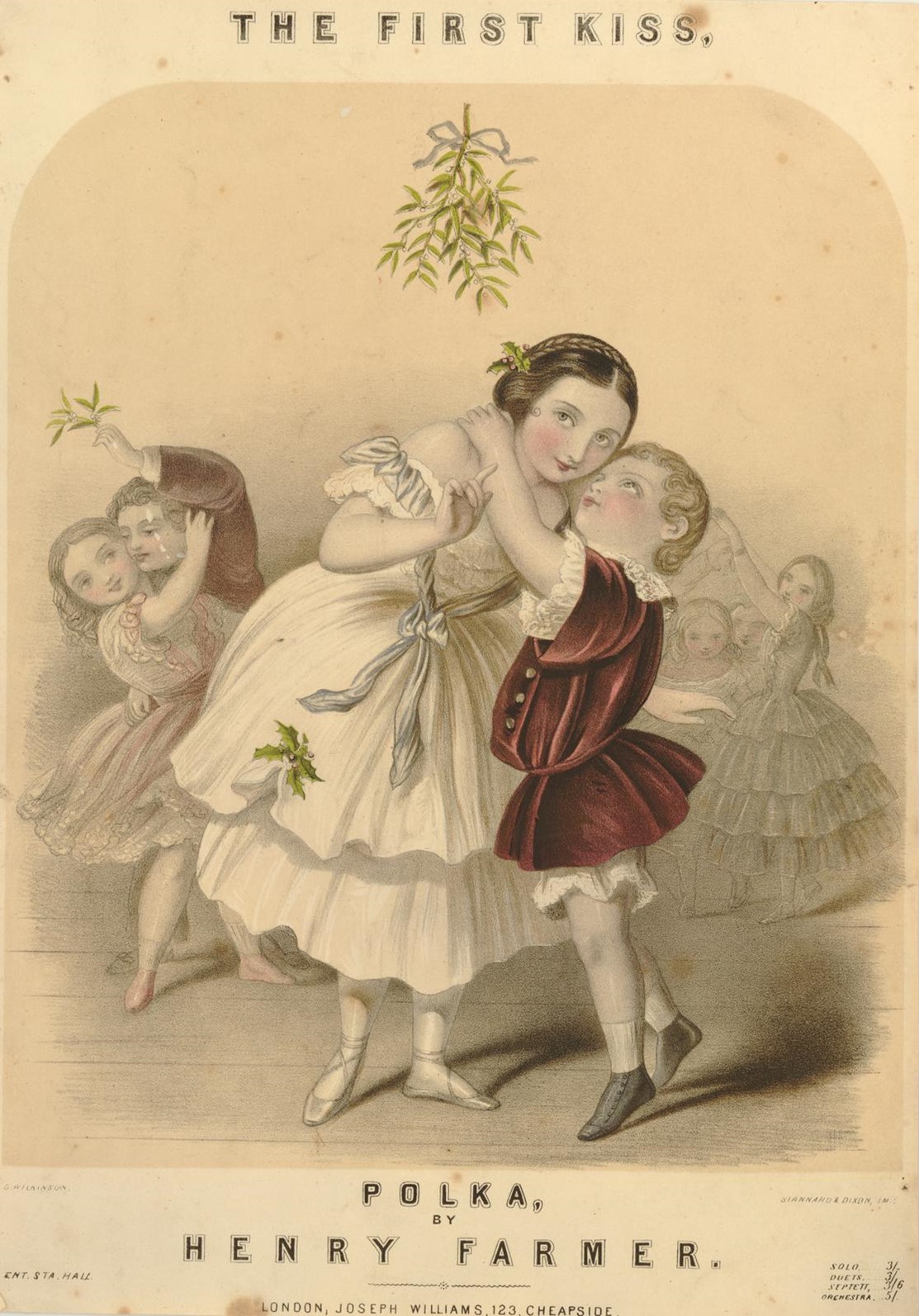
Credit: British Museum, public domain, via Wikimedia Commons
The best thing about mistletoe, you may have thought, is that you can get a holiday kiss under it. But mistletoe is vital to the ecosystems it lives in.
Mistletoes are surprisingly diverse. There are over 1,000 species living on every continent but Antarctica and in every environment, from forest to desert.
They’re all parasites that grow on grasses, ferns and, most famously, trees. They attach with a haustorium, sort of a root that pierces the plant’s exterior to tap into its xylem to draw water and nutrients.
Most are evergreen, conducting photosynthesis to produce sugars. Most also produce flowers, which are full of sugary nectar, a high-energy food for bees and butterflies.
And most produce berries, which feed many species of birds—for some, it’s their only winter food. Some larger animals like possums, porcupines, deer and rhinos eat the mistletoe itself.
And its leaf litter is concentrated with nutrients stolen from host trees to enrich the forest soil.
Mistletoe is so essential that scientists have found that removing it from some forests reduces bird species by 25%.
While mistletoe is poisonous to humans, Native Americans used small doses to treat aches, epilepsy, and high blood pressure. And modern medicine is experimenting with it as therapy in cancer treatment.
Whether or not you get a kiss under it, mistletoe is still a plant to love.
Background
Synopsis: For many, mistletoe evokes fond images of romantic winter holiday festivities. On the bright side, evergreen mistletoe provides year-round shelter and sustenance for animals while its leaf litter concentrates nutrients, enriching the forest floor food web and increasing biodiversity. However, mistletoe has a dark side as a parasite that siphons water and nutrients from its host tree. Regardless, this parasitic plant is a keystone species in some ecosystems.
- Evergreen mistletoe symbolizes romantic holiday cheer where Christmas is celebrated. The plant has been celebrated in many holiday songs by artists ranging from Frank Sinatra (1957) to Justin Bieber (2011).
- In ancient times, mistletoe was regarded as the plant of peace, luck and friendship.
- Druids believed this plant that defied winter to stay green among the bare tree branches contained the spirit of the tree and was magical. It was said to increase vitality and fertility as well as healing any ailment. They would wear it in amulets for their well-being and hang it over doors to indicate old grievances were forgotten. They also used it in ceremonies to ensure a bountiful harvest in the next year.

European mistletoe (Viscum album) in the snow in eastern France.
Credit: SwordSmurf, public domain, via Wikimedia Commons - The tradition of kissing under mistletoe is thought to have originated from a story from old Norse mythology involving the Norse goddess of love, Frigg. Her son, Baldur, was killed with a mistletoe arrow, so she proclaimed the plant to be a symbol of love and promised to kiss anyone who walked beneath the plant.
- The tradition of kissing under the mistletoe was first referenced in 1784, in a song from the musical comedy Two to One. “What all the men, Jem, John, and Joe, Cry, ‘What good luck has sent ye?’ And kiss beneath the mistletoe, The girl not turn’d of twenty.”
- In 1820, American author Washington Irving described the English custom in his bestselling The Sketch Book, alongside his short stories “Rip van Winkle” and “The Legend of Sleepy Hollow:” “The mistletoe is still hung up in farmhouses and kitchens at Christmas, and the young men have the privilege of kissing the girls under it, plucking each time a berry from the bush. When the berries are all plucked the privilege ceases.”
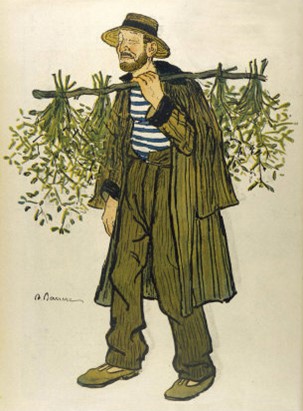
The Mistletoe Seller, a poster published around 1930 in France.
Credit: Adrien Barrère, public domain, via Wikimedia Commons - Traditions for kissing under the mistletoe vary among different areas but include the following: You can’t refuse a kiss, or you will have bad luck; you must pick a berry for each kiss; a young girl will dream of her future husband if she sleeps with mistletoe under her pillow.
- But there is a sinister side to the plant. In the mistletoe family, Loranthaceae, there are more than 1,000 species in about 75 genera, all of which are parasitic.
- Three of the genera are tree-root parasites, and the remaining 72 are aerial stem or branch parasites.
- They occur on every continent except Antarctica in settings as varied as deserts, rain forests, and volcanic islands.
- Various species are hosted on diverse plants, including ferns, grasses and trees.
- The aerial parasites in this family evolved during the Eocene Epoch, around 40 million years ago. Moving from exploiting root systems to tree canopies provided them with access to the light they required for photosynthesis.
- Most mistletoes are obligate hemiparasitic plants with branches ranging from 4 to 32 inches (10–80 cm) long.
- Obligate means they cannot complete their life cycle without a host.
- Hemiparasitic means they remain photosynthetic but obtain their water and mineral nutrients from the xylem (part of the vascular system) of their host. Mistletoes are evergreen, producing their own photosynthetic glucose for energy, but they must access the water and nutrients that are transported from the roots to the canopy via the tree’s xylem.
- Some mistletoes may also access the host’s phloem (another part of the vascular system) to steal organic nutrients produced by the host tree during photosynthesis.
- A few mistletoes are holoparasitic, lacking chlorophyll and depending on the host for all their needs.
- They grow very slowly for decades on hosts, especially oak, willow, apple, poplar, juniper and elm trees. But they can sprout on any tree.
- Mistletoes attach to their hosts using a haustorium, which invades the bark and sneaks through the cambium (the part of the plant that makes stems and branches grow in thickness) until it reaches and taps into the xylem.
- Butterflies, bees and ants pollinate the inconspicuous but nectar-rich mistletoe flowers. While some mistletoes sport festive flowers, the holiday varieties lack petals, appearing as inconspicuous greenish-yellow sepals.
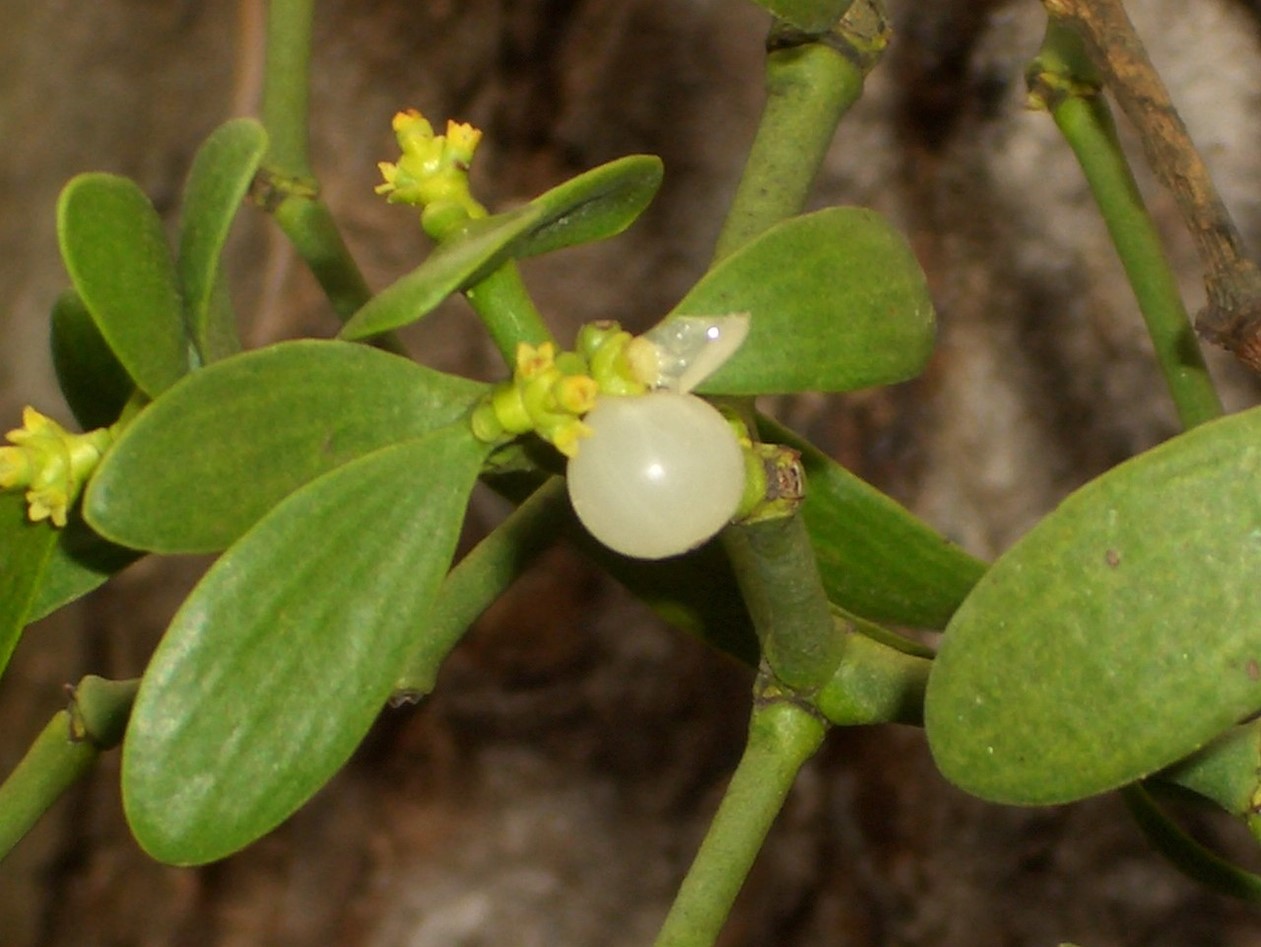
Leaves, flowers and berries of fir mistletoe (Viscum album subsp. abietis) in the Berlin Botanical Garden
Credit: Hanson59, via Wikimedia Commons - Mistletoe berries contain one or more seeds within a sticky juice called viscin and may be white, yellow, orange or red.
- A few species have berries that explode and can disperse seeds as far as 50 ft (15 m) away.
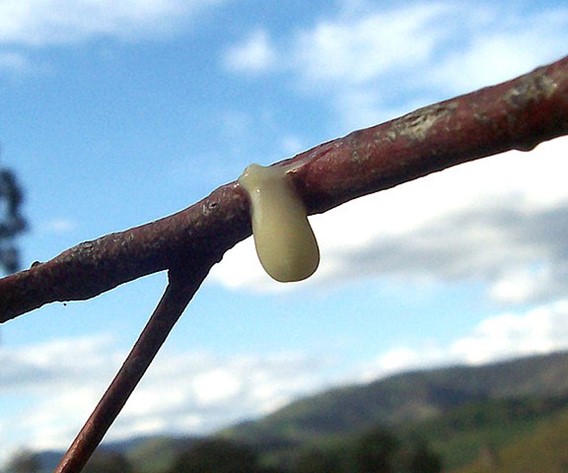
Mistletoe seed attached to a branch by viscum, transported in bird droppings. Mistletoe comes from the Anglo-Saxon miseltan, meaning “dung on a twig,” because they sprout where birds defecate.
Credit: Fir0002, via Wikimedia Commons - But most species depend on birds like cedar waxwings, bluebirds, thrushes, finches and silky flycatchers to disperse the seeds when they eat the berries and excrete or regurgitate the sticky seed-filled viscin onto branches where it hardens.

Mistletoe seed attaching itself to a branch via its haustorium.
Credit: Krzysztof Ziarnek, Kenraiz, CC BY-SA 4.0, via Wikimedia Commons - Once attached to the branch, it may take a year for seeds to germinate, producing the haustorium that penetrates the host’s bark and cambium to root into the xylem and phloem. Only then can the plant rely on the host.

Cross section of European Mistletoe (Viscum album) growing on a branch of a hybrid black poplar (Populus × canadensis) from Ukraine.
Credit: George Chernilevsky, public domain, via Wikimedia Commons - The diversion of resources from the host to the mistletoe stresses the host, resulting in slower growth rates, lower fruit productivity, and increased susceptibility to insects and disease.
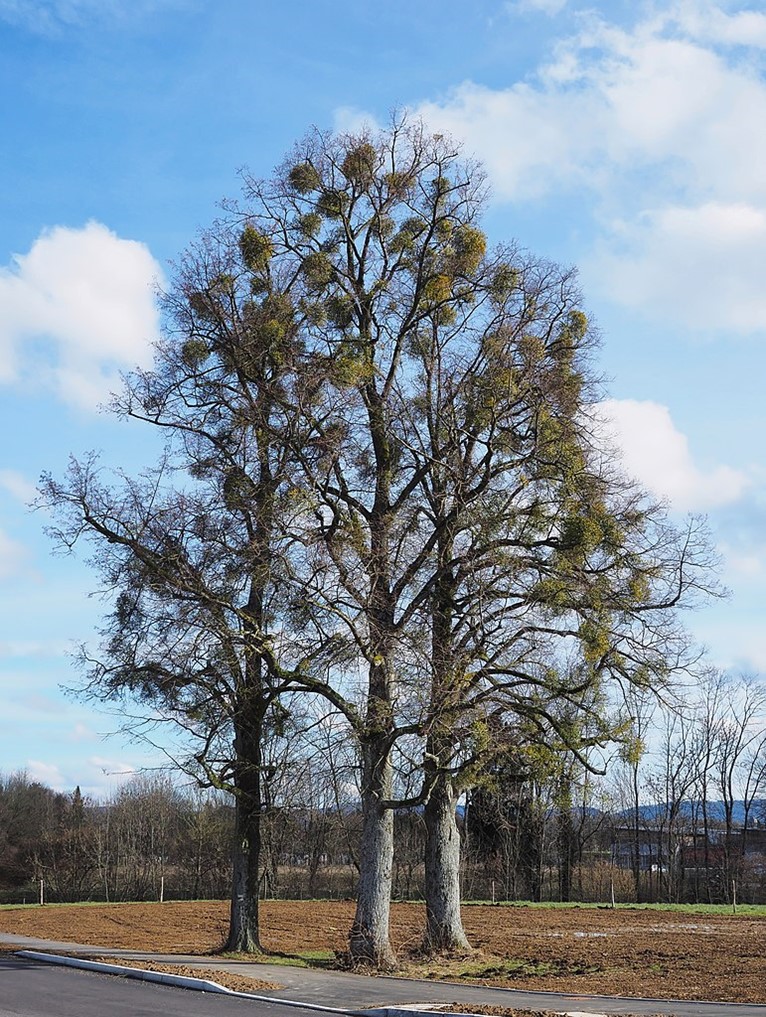
A group of trees heavily infested with mistletoe.
Credit: Kreuzschnabel, via Wikimedia Commons
- Butterflies, bees and ants pollinate the inconspicuous but nectar-rich mistletoe flowers. While some mistletoes sport festive flowers, the holiday varieties lack petals, appearing as inconspicuous greenish-yellow sepals.
- The silver lining to the mistletoe story is that mistletoe has been characterized as a keystone species by the U.S. Geological Survey—it is essential to forest ecosystems because it provides a food resource, shelter, shade and even cools the tree canopy.
- Because of the high water content in their tissues, mistletoes are cooler than the surrounding canopies—they actually feel cool to the touch.
- Like a dependable fertilizer, mistletoe leaf litter contains concentrated nutrients and amino acids that enrich forest soils and the food web that lives there, increasing biodiversity of both flora and fauna.
- Birds and other animals tend to more frequently nest in or gather under trees with mistletoe.
- In Australia, 245 bird species are known to nest in mistletoe.
- Birds like cedar waxwings, finches and silky flycatchers depend almost entirely on mistletoe berries for food in the winter.
- Hummingbirds in South America pollinate mistletoes and other plants, in areas where the mistletoes have disappeared, the birds have migrated to follow the nectar. That means the other plants are not pollinated, creating local food web havoc.
- Studies in Australia and Mexico have shown that if mistletoe is removed from an ecosystem, the number of bird species may decrease by as much as 25%, and other insect-eating animals are also impacted.
- Some butterfly caterpillars (the great purple hairstreak, the Johnson’s hairstreak, and the thicket hairstreak) will only feed on mistletoes.
- Extensive interactions occur between mistletoe and dozens of vertebrates. Lizards and birds hunt for insects in mistletoe clumps while larger animals like deer, porcupines, rhinoceroses and opossums feed on mistletoe.
- Studies show that warming temperatures have resulted in less synchronization among seasonal floral and faunal rhythms, which has caused some woodland species to become more reliant on the nectar, fruits and flowers of these year-round parasitic plants.
- However, mistletoes are also struggling, because they have no way to store carbohydrates.
- If they lose the photosynthetic machinery that converts light energy to food energy in their leaves, they will die.
- The holiday mistletoe we are familiar with in North America is from a different genus than the mistletoe native to Europe.
- The native mistletoes of North America are from the genus Phoradendron, with Phoradendron leucarpum serving as the traditional North American holiday mistletoe.

Phoradendron leucarpum is native to North America. It has broad oval leaves and clusters of ten or more berries.
Credit: Douglas Goldman, CC BY-SA 4.0, via Wikimedia Commons- In Greek, phor means “thief” and dendron means “tree,” so this plant steals from the tree. It has broader leaves than the European variety and has clusters of ten or more berries.
- Indigenous North Americans used native species for medicine and religious ceremonies. The Cherokee people used it as a treatment for headaches, epilepsy and high blood pressure. Mendocino people used it to soothe painful joints.
- The most common mistletoes in Europe are from the genus Viscum.
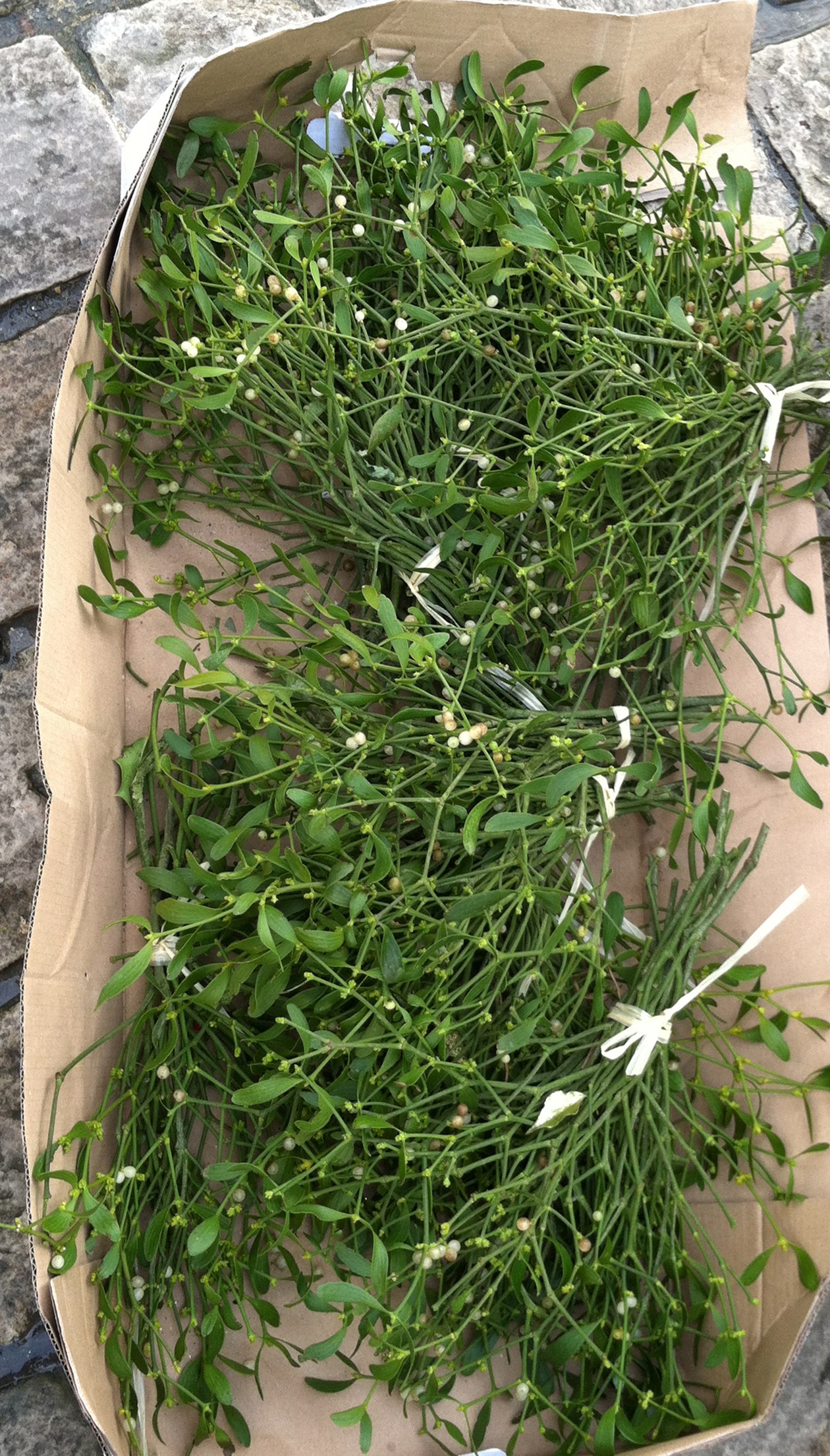
European mistletoe (Viscum album) plants gathered for sale at an open market in Versailles, France, at Christmas season. Their leaves are smaller, with clusters of two to six berries.
Credit: Didier Olmstead, via Wikimedia Commons- European holiday mistletoe is Viscum album, with pairs of oval leaves and white berries in groups of two to six.
- Viscum album was first introduced to North America in California around 1900.
- Viscum mistletoes are more toxic than those native to North America, and may cause vomiting, difficulty breathing, and a decrease in blood pressure and pulse. However, European mistletoe has recently been regarded as a therapy for cancer or to decrease the discomfort of chemotherapy, but some studies refute the benefit. Use it only under the guidance of a medical professional.
- The native mistletoes of North America are from the genus Phoradendron, with Phoradendron leucarpum serving as the traditional North American holiday mistletoe.

